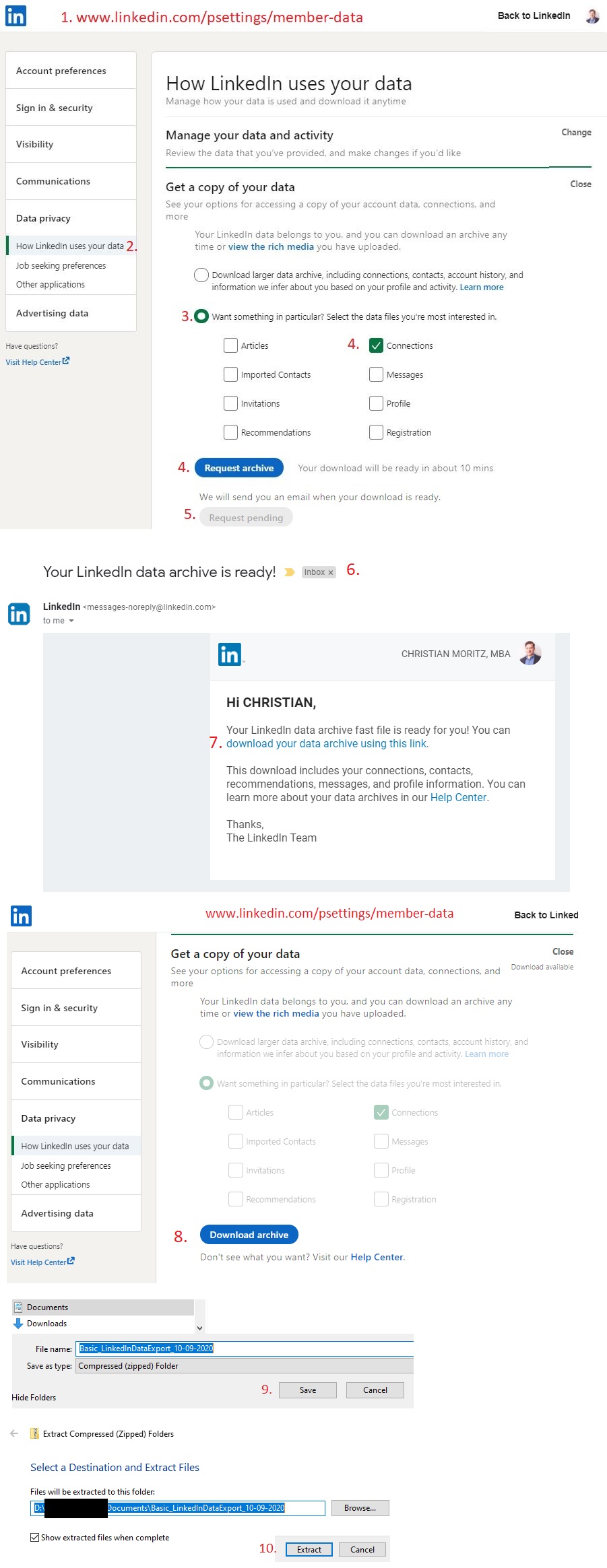In today's digital age, networking is essential for professional growth, and LinkedIn has become the go-to platform for connecting with industry peers. If you're looking to leverage your LinkedIn connections for better opportunities, exporting your contacts to Excel is a smart move. Not only can you organize your network, but you can also analyze connections, identify potential collaborations, and reach out more effectively. In this post, we'll uncover why exporting your
Why Exporting LinkedIn Contacts is Beneficial

Exporting your LinkedIn contacts to an Excel spreadsheet comes with a multitude of benefits that can significantly optimize your networking strategy. Let's explore some of the key advantages:
- Centralized Organization: By exporting your LinkedIn contacts, you create a centralized database. This means you can categorize, sort, and manage your connections in one place, making it easier to find and interact with them.
- Personalized Outreach: When you have your contacts in Excel, you can personalize your communications based on their details. You can segment your network by industry, location, or job title, and tailor your messages accordingly.
- Tracking Connections: Keeping track of how you interact with your contacts can be challenging on LinkedIn alone. When exported, you can add notes, record conversations, and set reminders for follow-ups right in the spreadsheet.
- Data Analysis: An Excel sheet allows for data analysis, enabling you to see trends and gaps in your networking efforts. You might discover that you have many connections in one field but none in another area of interest.
- Custom Reporting: You can create custom reports for any upcoming networking events or meetings. A clear view of your connections can help you identify who to reach out to before attending these events.
- Offline Access: Having your contacts in Excel means you can access them without needing an internet connection. This is particularly useful when you're on the go or in situations where you can’t access LinkedIn.
Exporting your LinkedIn contacts not only helps manage your professional network better but also positions you to utilize these connections effectively. In an age where every relationship counts, having a strategic approach through data can open doors to opportunities you might not have otherwise considered. So, if you’re serious about maximizing your LinkedIn experience, exporting your contacts is the first step!
Also Read This: Understanding the Cost of LinkedIn Navigator and Its Benefits
3. Step-by-Step Guide to Export LinkedIn Contacts to Excel

Exporting your LinkedIn contacts to Excel may seem daunting at first, but with a simple step-by-step approach, you can have all your valuable connections at your fingertips in no time! Here’s how to do it:
-
Log in to Your LinkedIn Account:
First, head to LinkedIn.com and sign in using your credentials. Make sure you’re on your home page before proceeding.
-
Access the Settings & Privacy:
On the top right corner of your LinkedIn homepage, click on your profile picture. From the dropdown menu, select “Settings & Privacy.”
-
Find Data Privacy Settings:
Navigate to the “Data privacy” section in the left sidebar. Here, you'll find various options to manage your data.
-
Request Your Data:
Click on “Get a copy of your data.” LinkedIn allows you to download specific information, so select “Connections” and any other data you might want, then click on “Request archive.”
-
Download the Data:
LinkedIn will process your request, and you’ll receive an email when your data is ready. This can take a few minutes to a couple of hours, so be patient!
Once you receive the email, follow the provided link to download a .CSV file containing your contacts.
-
Open Your CSV File in Excel:
Once downloaded, open the .CSV file using Excel. You’ll see a neatly organized list of your LinkedIn contacts, along with their details like names, email addresses, and job titles.
And voilà! You’ve successfully exported your LinkedIn contacts to Excel. Now, let’s talk about how to organize them for even better networking.
Also Read This: How to Reach Out to Recruiters on LinkedIn and Improve Your Job Search
4. Tips for Organizing Your Contacts in Excel

Having your LinkedIn contacts in Excel is a fantastic first step, but organizing them effectively is key to maximizing your networking potential. Here are some tips to get you started:
-
Use Columns Wisely:
Make sure your Excel sheet has clear headers for each category of information. For instance, you might have columns for:
- Name
- Email Address
- Current Position
- Company
- Location
- Notes
-
Sort and Filter:
Excel has great sorting and filtering tools. You can sort contacts by company, location, or any other criteria that are relevant to you. This makes it easy to find who you need when you need them!
-
Add Personal Notes:
In the “Notes” column, jot down details such as how you met or specific topics of interest you may share. This helps you remember personal aspects of your connections and can spark conversations later.
-
Utilize Color-Coding:
Color-code your contacts based on categories like “Potential Client,” “Mentor,” or “Former Colleague.” This visual cue can speed up your networking strategy.
-
Regular Updates:
Make it a habit to update your Excel sheet regularly. If you gain new connections or if existing relationships evolve, add that information promptly to keep your network organized.
By following these tips, you’ll transform your Excel contacts list into a powerful networking tool. Remember, organization is key to leveraging your connections effectively. Happy networking!
Also Read This: How Many LinkedIn Connections Can You Send Per Week?
5. Best Practices for Networking After Exporting Contacts

Now that you have your LinkedIn contacts neatly exported into an Excel file, it's time to put that valuable information to good use! Networking effectively is about more than just collecting names; it’s about building and maintaining relationships. Here are some best practices to maximize your networking potential:
- Organize Your Contacts: Take the time to categorize your contacts based on industry, location, or how you know them. You might create separate sheets or columns in Excel for each category to help you tailor your outreach. For instance, you may want to have different strategies for contacting colleagues, clients, or mentors.
- Personalize Your Communication: Referencing past conversations or shared experiences can help make your outreach feel more genuine. Instead of sending a generic message, customize your emails or LinkedIn messages based on what you know about the person. This could be as simple as reminding them of a shared project or complimenting their recent accomplishments.
- Follow-Up Regularly: Keeping relationships warm doesn’t have to be time-consuming. Schedule periodic check-ins or share relevant articles that might interest your contacts. A quick message stating you thought of them because of an article can strengthen your bond and keep the lines of communication open.
- Join Networking Groups: Consider joining professional groups or forums related to your industry. Engage with both your exported contacts and new connections. These groups often provide great opportunities for introductions and referrals.
- Track Your Interactions: Use your Excel file to note down when you last contacted each person and any relevant details about your conversations. This will help you remember key points for future interactions and ensure you’re not reaching out too often or too little.
By implementing these best practices, you can turn that list of contacts into a powerful network that fosters professional growth and opportunities. Remember, networking is like gardening; it requires care, attention, and consistency for fruitful results!
Also Read This: How to Add Projects to LinkedIn and Highlight Your Work
6. Common Issues and Troubleshooting During Export
Sometimes, the journey to export your LinkedIn contacts into Excel isn’t as smooth as we'd like it to be. You might encounter a few bumps along the way. Here’s a quick guide to some common issues and troubleshooting tips to help you navigate them:
- Export Not Working: If the export option isn’t functioning, try refreshing the page or logging out and back into LinkedIn. Clear your browser’s cache and cookies as well. This often resolves temporary glitches.
- Incomplete Data: If the Excel file appears to have missing information (like email addresses or phone numbers), double-check your LinkedIn settings to ensure that your contacts have provided their details and that you have permission to view them.
- File Format Issues: If you’re having trouble opening the exported CSV file in Excel, make sure you’re using a compatible version of Excel. If all else fails, try converting the CSV file to a different format that Excel can open, such as .xls.
- Duplicates in Contacts: It’s not unusual to find duplicate entries in your exported list. You can use Excel's built-in “Remove Duplicates” feature, found under the Data tab, to clean up your list and ensure each contact is unique.
- Incorrect Formatting: Sometimes fields may not display correctly in Excel (like dates or phone numbers). Check the formatting options in Excel and adjust them accordingly to make sure all information appears as intended.
Networking and data management can be tricky, but with these troubleshooting tips in your back pocket, you'll be well-equipped to handle any issues. Remember, don't get discouraged; each problem has a solution, and your networking journey will be worth the effort!
Conclusion and Next Steps for Enhanced Networking
In conclusion, exporting your LinkedIn contacts to Excel can significantly streamline your networking efforts. By organizing your connections in a spreadsheet, you gain a clearer perspective on your professional relationships and can strategize your outreach effectively. Here are a few next steps to enhance your networking:
- Review and Clean Your Contacts: Take the time to go through your exported list and remove any duplicates or outdated entries.
- Segment Your Connections: Group your contacts based on criteria such as industry, location, or how you know them. This will help you tailor your communication.
- Set Networking Goals: Define what you aim to achieve with your networking efforts, whether it's seeking mentorship, job opportunities, or collaborations.
- Create an Outreach Plan: Outline a strategy for reaching out to your contacts, including personalized messages and follow-up schedules.
- Track Your Interactions: Use your Excel sheet to record your interactions with each contact, such as emails sent, meetings scheduled, and responses received.
By implementing these steps, you'll not only make the most of your LinkedIn contacts but also foster stronger professional relationships. Regularly revisit and update your contact list to ensure it remains a valuable tool in your networking arsenal.
 admin
admin








